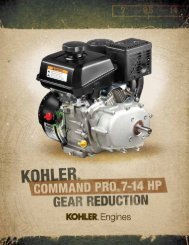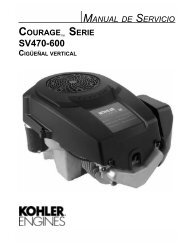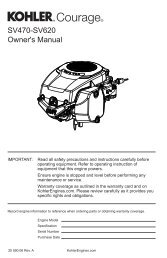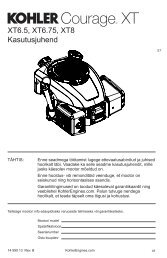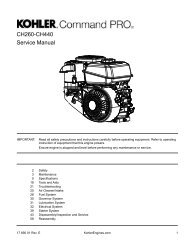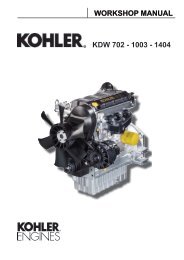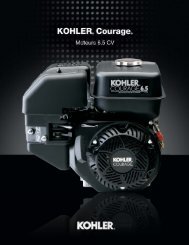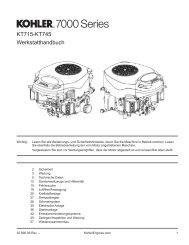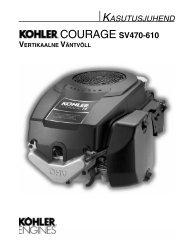Create successful ePaper yourself
Turn your PDF publications into a flip-book with our unique Google optimized e-Paper software.
COMMAND PRO CS SERIES 4-12.75 HPHORIZONTAL CRANKSHAFTOWNER'S MANUAL
WARNINGSafety Precautions (Cont.)WARNINGWARNINGAccidental Starts can cause severeinjury or death.Disconnect and ground spark pluglead before servicing.Accidental Starts!Disabling engine. Accidentalstarting can cause severe injuryor death. Before working on theengine or equipment, disable theengine as follows: 1) Disconnect thespark plug lead(s). 2) Disconnectnegative (-) battery cable frombattery.Carbon Monoxide can causesevere nausea, fainting or death.Do not operate engine in closed orconfined area.Lethal Exhaust Gases!Engine exhaust gases containpoisonous carbon monoxide.Carbon monoxide is odorless,colorless, and can cause death ifinhaled. Avoid inhaling exhaustfumes, and never run the engine ina closed building or confined area.Explosive Gas can cause fires andsevere acid burns.Charge battery only in a wellventilated area. Keep sources ofignition away.Explosive Gas!Batteries produce explosivehydrogen gas while being charged.To prevent a fire or explosion,charge batteries only in wellventilated areas. Keep sparks, openflames, and other sources of ignitionaway from the battery at all times.Keep batteries out of the reach ofchildren. Remove all jewelry whenservicing batteries.Before disconnecting the negative(–) ground cable, make sure allswitches are OFF. If ON, a spark willoccur at the ground cable terminalwhich could cause an explosion ifhydrogen gas or gasoline vaporsare present.Congratulations – You have selected a fine four-cycle, single cylinder, air-cooled engine. <strong>Kohler</strong> designs longlife strength and on-the-job durability into each engine…making a <strong>Kohler</strong> engine dependable…dependability youcan count on. Here are some reasons why:• Efficient overhead valve design and splash lubrication provide maximum power, torque, and reliability underall operating conditions.• Dependable, maintenance free electronic ignition ensures fast, easy starts time after time.• <strong>Kohler</strong> engines are easy to service. All routine service areas (like the oil fill/check plug, air cleaner, spark plug,and carburetor) are easily and quickly accessible.• Parts subject to the most wear and tear (like the cylinder liner, crankshaft, and camshaft) are made fromprecision formulated cast iron. Because the cylinder liner can be rebored, these engines can last even longer.• Every <strong>Kohler</strong> engine is backed by a worldwide network of over 10,000 distributors and dealers. Servicesupport is just a phone call away. Call 1-800-544-2444 (U.S. & Canada) for Sales & Service assistance.To keep your engine in top operating condition, follow the maintenance procedures in this manual.3
Air CleanerAir CleanerCover RetainingKnobFuel Tank CapFuel TankMuffler ShieldOn/Off Switch(some models)MufflerOil SentryLightFuelShut-OffSpark PlugValve CoverChoke LeverRetractable StarterThrottle LeverOil Fill/Check PlugOil DrainCarburetorFigure 1. Location of Controls and Service Points on CS <strong>Engines</strong>.Oil RecommendationsUsing the proper type and weight of oil in the crankcaseis extremely important. So is checking oil daily andchanging oil regularly. Failure to use the correct oil, orusing dirty oil, causes premature engine wear andfailure.Oil TypeUse high quality detergent oil of API (AmericanPetroleum Institute) service class SG, SH, SJ orhigher. Select the viscosity based on the airtemperature at the time of operation as shown in thefollowing table.NOTE:Using other than service class SG, SH, SJ orhigher oil or extending oil change intervalslonger than recommended can cause enginedamage.A logo or symbol on oil containers identifies the APIservice class and SAE viscosity grade. See Figure 3.Figure 3. Oil Container Logo.Refer to “Maintenance Instructions” beginning onpage 8 for detailed oil check and oil changeprocedures.Synthetic oils should not be used.Figure 2. Viscosity Grades Table.4
Fuel RecommendationsWARNING: Explosive Fuel!Gasoline is extremely flammable and its vapors canexplode if ignited. Store gasoline only in approvedcontainers, in well ventilated, unoccupied buildings,away from sparks or flames. Do not fill the fuel tankwhile the engine is hot or running, since spilled fuelcould ignite if it comes in contact with hot parts orsparks from ignition. Do not start the engine near spilledfuel. Never use gasoline as a cleaning agent.General RecommendationsPurchase gasoline in small quantities and store inclean, approved containers. A container with a capacityof 2 gallons or less with a pouring spout isrecommended. Such a container is easier to handleand helps eliminate spillage during refueling.Do not use gasoline left over from the previous season,to minimize gum deposits in your fuel system and toensure easy starting.Do not add oil to the gasoline.Do not overfill the fuel tank. Leave room for the fuel toexpand.Fuel TypeFor best results use only clean, fresh, unleadedgasoline with a pump sticker octane rating of 87 orhigher. In countries using the Research method, itshould be 90 octane minimum.Unleaded gasoline is recommended as it leaves lesscombustion chamber deposits. Leaded gasoline may beused in areas where unleaded is not available andexhaust emissions are not regulated. Be awarehowever, that the cylinder head will require morefrequent service.Gasoline/Alcohol blendsGasohol (up to 10% ethyl alcohol, 90% unleadedgasoline by volume) is approved as a fuel for <strong>Kohler</strong>engines. Other gasoline/alcohol blends are notapproved.Gasoline/Ether blendsMethyl Tertiary Butyl Ether (MTBE) and unleadedgasoline blends (up to a maximum of 15% MTBE byvolume) are approved as a fuel for <strong>Kohler</strong> engines.Other gasoline/ether blends are not approved.Engine Identification NumbersWhen ordering parts, or in any communication involvingan engine, always give the Model, Specification, andSerial Numbers of the engine.The engine identification numbers appear on a decal(or decals) affixed to the engine shrouding. Includeletter suffixes, if there are any.Record your engine identification numbers on theidentification label below (Figure 4) for future reference.IMPORTANT ENGINE INFORMATIONTHIS ENGINE MEETS U.S. EPA PHASE II, 2002-2005CALIFORNIA AND EC STAGE II (SN:4) EMISSIONCONTROL REGS FOR SI SMALL OFF–ROADENGINESFAMILYTYPE APPMODEL NO.SPEC. NO.DISPL. (CC)SERIAL NO.OEM PROD. NO.EMISSION COMPLIANCE PERIOD:EPA: CATEGORY ACERTIFIED ON: UNLEADED GASOLINEREFER TO OWNER'S MANUAL FOR SAFETY,MAINTENANCE SPECS, AND ADJUSTMENTS1-800-544-2444 www.kohlerengines.comKOHLER CO. KOHLER, WISCONSIN USAFigure 4. Engine Identification Label.The Emission Compliance Period referred to on theEmission Control or Air Index label indicates thenumber of operating hours for which the engine hasbeen shown to meet Federal and CARB emissionrequirements. The following table provides the EngineComplicance Period (in hours) associated with thecategory descriptor found on the certification label.Emission Compliance Period (Hours)EPACARB(REF:_______________ )Category C250 HoursModerate125 HoursN432Category B500 HoursIntermediate250 HoursCategory A1000 HoursExtended500 HoursRefer to certification label for engine displacement.Exhaust Emission Control System for modelsCS4-12.75 is EM.5
Operating InstructionsAlso read the operating instructions of the equipment this engine powers.Pre-Start ChecklistNOTE: This engine has been shipped without engineoil. Fill with oil, otherwise it will not start.Starting1. Turn fuel shut-off valve to ‘‘on’’ position. SeeFigure 6.• Check oil level. Add oil if low. Do not overfill.• Check fuel level. Add fuel if low.• Check cooling air intake areas and externalsurfaces of engine. Make sure they are clean andunobstructed.• Check that the air cleaner components and allshrouds, equipment covers, and guards are inplace and securely fastened.• Check that any clutches or transmissions aredisengaged or placed in neutral.WARNING: Lethal Exhaust Gases!Engine exhaust gases contain poisonous carbonmonoxide. Carbon monoxide is odorless, colorless,and can cause death if inhaled. Avoid inhaling exhaustfumes, and never run the engine in a closed building orconfined area.Cold Weather Starting Hints1. Be sure to use the proper oil for the temperatureexpected. See Figure 2 on page 4.2. Declutch all possible external loads.3. Set speed control at part throttle position.4. A warm battery has much more starting capacitythan a cold battery.Figure 6. ‘‘On’’ Position of Fuel Shut-Off Valve.2. For a Cold Engine – Place the throttle controlmidway between the “slow” and “fast” positions.See Figure 5. Place the choke control into the “on”position.For a Warm Engine (normal operatingtemperatures) – Place the throttle control midwaybetween the “slow” and “fast” positions. Thechoke is not required to start a warm engine.3. Start the engine as follows:For Retractable Start Engine – Turn engineOn/Off switch to ‘‘on’’ (see Figure 7) and SLOWLYpull the starter handle until just past compression –STOP! Return starter handle, pull firmly with asmooth, steady motion to start. Pull the handlestraight out to avoid excessive rope wear from thestarter rope guide.5. Use fresh winter grade fuel. NOTE: Winter gradegasoline has a higher volatility to improve starting.Do not use gasoline left over from summer.ChokeControlFigure 5. Control Panel.ThrottleControlFigure 7. Retractable Start Engine On/Off Switch.Extend the starting rope periodically and check itscondition. If the rope is frayed, have it replacedimmediately by your <strong>Kohler</strong> Engine Service Dealer.6
WARNING: Accidental Starts!Disabling engine. Accidental starting can causesevere injury or death. Before working on the engineor equipment, disable the engine as follows: 1)Disconnect the spark plug lead(s). 2) Disconnectnegative (-) battery cable from battery.For an Electric Start Engine – Activate thestarter switch. Release the switch as soon as theengine starts.OffOnStartStopping1. If possible, remove the load.2. Move the throttle control to the “slow” or “low”idle position. Allow the engine to run at idle for30-60 seconds.3. Move the throttle control to the “slow” position.Turn key switch or on/off switch to ‘‘off’’ position.4. Close fuel shut-off valve.BatteryA 12 volt battery is normally used. Refer to theoperating instructions of the equipment this enginepowers for specific battery requirements.If the battery charge is not sufficient to crank theengine, recharge the battery (see page 12).OperatingFigure 8. Electric Start Engine Starter Switch.NOTE:NOTE:Do not crank the engine continuously formore than 10 seconds at a time. If theengine does not start, allow a 60 secondcool down period between startingattempts. Failure to follow theseguidelines can burn out the starter motor.If the engine develops sufficient speed todisengage the starter but does not keeprunning (a false start), the engine rotationmust be allowed to come to a completestop before attempting to restart theengine. If the start is engaged while theflywheel is rotating, the starter pinion andflywheel ring gear may clash, resulting indamage to the starter.If the starter does not turn the engine over, shut offstarter immediately. Do not make further attempts tostart the engine until the condition is corrected. Do notjump start using another battery (refer to "Battery").See your <strong>Kohler</strong> Engine Service Dealer for troubleanalysis.4. For a Cold Engine – Gradually return the chokecontrol to the “off” position after the engine startsand warms up.The engine/equipment may be operated during thewarm up period, but it may be necessary to leavethe choke partially on until the engine warms up.Angle of OperationThis engine will operate continuously at angles upto 20°. Check oil level to assure crankcase oil is up tothe point of overfilling the filler neck.Refer to the operating instructions of the equipmentthis engine powers. Because of equipment design orapplication, there may be more stringent restrictionsregarding the angle of operation.NOTE:Do not operate this engine continuously atangles exceeding 20° in any direction. Enginedamage could result from insufficientlubrication.CoolingNOTE: If debris builds up on the grass screen orother cooling air intake areas, stop the engineimmediately and clean. Operating the enginewith blocked or dirty air intake and coolingareas can cause extensive damage due tooverheating.WARNING: Hot Parts!Engine components can get extremely hot fromoperation. To prevent severe burns, do not touch theseareas while the engine is running–or immediately afterit is turned off. Never operate the engine with heatshields or guards removed.Engine SpeedNOTE: Do not tamper with the governor setting toincrease the maximum engine speed.Overspeed is hazardous and will void theengine warranty.7
Maintenance InstructionsMaintenance, repair, or replacement of the emission control devices and systems, which are being doneat the customers expense, may be performed by any non-road engine repair establishment or individual.Warranty repairs must be performed by an authorized <strong>Kohler</strong> service outlet.WARNING: Accidental Starts!Disabling engine. Accidental starting can cause severe injury or death. Before working on the engine orequipment, disable the engine as follows: 1) Disconnect the spark plug lead(s). 2) Disconnect negative (-) batterycable from battery.Maintenance ScheduleThese required maintenance procedures should be performed at the frequency stated in the table. They shouldalso be included as part of any seasonal tune-up.FrequencyDaily or BeforeStarting EngineEvery 25 HoursEvery 100 HoursAnnually orEvery 300 HoursMaintenance Required• Fill fuel tank.• Check oil level.• Check air cleaner for dirty, loose, or damaged parts. 1• Check air intake and cooling areas, clean as necessary. 1• Check fuel hose for cracks or damage. Replace if necessary.• Check exhaust system for leakage. Retighten or replace gasket if necessary. 2• Check choke operation.• Check retractable starter operation.• Service precleaner element. Replace if necessary. 1• Change oil.• Replace air cleaner element. 1• Remove cooling shrouds and clean cooling areas. 1• Check all fittings and fasteners.• Clean fuel valve shut-off filter. Replace if necessary.• Check muffler screen/spark arrestor. Clean/replace if necessary.• Check spark plug condition, adjust gap, and clean. Replace if necessary.• Check and adjust valve clearance when engine is cold. 2• Check and adjust idle speed.• Service starter motor drive, if so equipped. 2• Check cooling fan for damage.• Have combustion chamber decarbonized. 2¹Perform these maintenance procedures more frequently under extremely dusty, dirty conditions.²Have a <strong>Kohler</strong> Engine Service Dealer perform this service.Check Oil LevelThe importance of checking and maintaining the properoil level in the crankcase cannot be overemphasized.Check oil BEFORE EACH USE as follows:1. Make sure the engine is stopped, level, and iscool so the oil has had time to drain into the sump.2. To keep dirt, debris, etc., out of the engine, cleanthe area around the oil fill/check plug beforeremoving it.3. Unthread and remove the oil fill/check plug.4. The level should be up to but not over, the point ofoverflowing the filler neck.Oil Fill/Check PlugOil Drain PlugFigure 9. Location of Oil Drain and Check Plugs.8
NOTE:Just because you can see oil in the crankcasedoesn't mean the level is in the safe range.Bring the level up to the point of overflowingthe filler neck.Filler NeckNOTE:If the engine stalls or does not start, turn theengine switch to ‘‘on’’ position and then pullthe recoil starter or attempt to start engine. Ifthe oil warning light flickers for a few seconds,the engine oil is insufficient. Add oil andrestart.Figure 10. Proper Oil Level.5. If the level is low, add oil of the proper type, up tothe point of overflowing the filler neck. (Refer to“Oil Type” on page 4.) Always check the levelbefore adding more oil.NOTE:Bring Level Up ToPoint of Overflow(Cutaway ShowingProper Oil Level)To prevent extensive engine wear ordamage, always maintain the proper oillevel in the crankcase. Never operate theengine with the oil level below the point ofoverflowing the filler neck.Oil Sentry<strong>Engines</strong> are equipped with an Oil Sentry oil monitor.When the oil level falls below the safe level, the enginestops automatically. Unless you refill with oil, theengine will not start again. See Figure 11.NOTE:Make sure the oil level is checked BEFOREEACH USE and is maintained up to the pointof overflowing the filler neck.Change OilFor a new engine, change oil after the first 20 hoursof operation. Thereafter, change oil after every 100hours of operation.For an overhauled engine, use 10W-30 – weightservice class SG, SH, SJ or higher oil for the first 20hours of operation. Change the oil after this initial runinperiod. Refill with service class SG, SH, SJ or higheroil as specified in the “Viscosity Grades” table (Figure2) on page 4.Change the oil while the engine is still warm. The oil willflow freely and carry away more impurities. Make surethe engine is level when filling, checking, or changingthe oil.Change the oil as follows (see Figure 9):1. To keep dirt, debris, etc., out of the engine, cleanthe area around the oil fill cap/dipstick beforeremoving it.2. Remove the oil drain plug and oil fill/check plug.Be sure to allow ample time for completedrainage.3. Reinstall the drain plug. Make sure it is tightenedto 17.6 N·m (13 ft. lb.) torque.4. Fill the crankcase, with new oil of the proper type,up to the point of overflowing the filler neck. Referto “Oil Type” on page 4. Always check the levelbefore adding more oil.5. Reinstall the oil fill/check plug and tighten securely.Figure 11.NOTE:To prevent extensive engine wear ordamage, always maintain the proper oillevel in the crankcase. Never operate theengine with the oil level below the point ofoverflowing the filler neck.9
Reduction Systems2:1 Reduction SystemsAll 2:1 reduction systems are lubricated by thecrankcase oil of the engine through special openings inthe closure plate. No special maintenance or service isnecessary. Check and maintain the oil level as outlinedon pages 8 and 9.6:1 Reduction SystemsCS4 and CS6: Use an internal pinion and ring gearsystem, independent of, and separated from the maincrankcase lubrication. See Figure 12. Use the sameweight oil in the reduction system that is being used inthe crankcase. Reduction System Capacity = .15liters (5.07 fl. oz.). Change the reduction system oilevery 300 hours as follows:1. Drain old oil out through the oil level/drain plug, tipengine as required.2. Engine must be level. Fill with new oil through theoil fill plug hole on top until the oil level is up to thebottom of the oil level/drain plug hole. Reinstallboth plugs securely.Oil Fill PlugNOTE:Operating the engine with loose or damaged aircleaner components could allow unfiltered airinto the engine causing premature wear andfailure.Service PrecleanerWash and reoil the precleaner every 25 hours ofoperation (more often under extremely dusty or dirtyconditions).1. Remove the outer cover of the air cleanerassembly and access the element.2. Remove the precleaner from the paper element.3. Wash the precleaner in warm water withdetergent. Rinse the precleaner thoroughly until alltraces of detergent are eliminated. Squeeze outexcess water (do not wring). Allow the precleanerto air dry.4. Saturate the precleaner with new engine oil andsqueeze out all excess oil.5. Reinstall the precleaner over the paper element.6. Reinstall and secure the air cleaner cover.Service Paper ElementEvery 100 hours of operation (more often underextremely dusty or dirty conditions), replace the paperelement.Oil Level/Drain PlugFigure 12. CS4 and CS6 6:1 Reduction System.CS8.5, CS10, and CS12: Use a gear reduction systemwhich is lubricated by the crankcase oil of the enginethrough holes in the closure plate. No specialmaintenance or service is necessary.Service Precleaner and Air Cleaner ElementThis engine is equipped with a replaceable, highdensity paper air cleaner element. All engines are alsoequipped with an oiled, foam precleaner which coversthe paper element. See Figure 13 on page 11.Check the air cleaner daily or before starting theengine. Check for a buildup of dirt and debris aroundthe air cleaner system. Keep this area clean. Alsocheck for loose or damaged components. Replace allbent or damaged air cleaner components.101. Remove the outer cover of the air cleanerassembly and access the element/precleanerassembly. Remove the wing nut securing theelement assembly, or pull the complete assemblyout of the cover/housing (some Heavy Duty AirCleaners). Separate the precleaner from theelement and service as outlined above.2. Do not wash the paper element or use pressurizedair, as this will damage the element. Replace adirty, bent, or damaged element with a genuine<strong>Kohler</strong> element. Handle new elements carefully;do not use if the sealing surfaces are bent ordamaged.3. When servicing the air cleaner, check the aircleaner base. Make sure it is secured and notbent or damaged. Check the air cleaner cover/housing for damage or improper fit. Replace allbent or damaged air cleaner components.On Standard Air Cleaner Systems:Before air cleaner is reassembled make surerubber seal is in position around stud. Inspect sealand replace if its condition is questionable in anyway.
On Heavy Duty Air Cleaner Systems:Remove and clean the lower dirt/swirl chamber.Make sure the openings near the base ofchamber and in the air cleaner cover/housing, arenot blocked or restricted. See Figure 13.4. Position the paper element on base and securewith wing nut, then install the precleaner over theelement. If element is not secured with a wing nut,place the precleaner over the element and install itas an assembly into the cover/housing. Narrowend must be installed first and face away the frombase.5. Reinstall and secure the outer cover/housing.Clean Air Intake/Cooling AreasTo ensure proper cooling, make sure the grass screen,cooling fins, and other external surfaces of the engineare kept clean at all times.Every 100 hours of operation (more often underextremely dusty, dirty conditions), remove the blowerhousing and other cooling shrouds. Clean the coolingfins and external surfaces as necessary. Make sure thecooling shrouds are reinstalled.NOTE:Operating the engine with a blocked grassscreen, dirty or plugged cooling fins, and/orcooling shrouds removed, will cause enginedamage due to overheating.Ignition SystemThis engine is equipped with a dependable electronicmagneto ignition system. Other than periodicallychecking/replacing the spark plug, no maintenance,timing, or adjustments are necessary or possible withthis system.In the event starting problems should occur which arenot corrected by replacing the spark plug, see your<strong>Kohler</strong> Engine Service Dealer for trouble analysis.Standard Dual Air Cleaner SystemKnobWing NutAir CleanerCoverSealPrecleanerAir CleanerElementHeavy Duty Air Cleaner SystemLatchesElementAir CleanerCover/HousingLower Swirl/DirtChamberFigure 13. Air Cleaner System Components.PrecleanerOpenings must not beblocked or restricted11
Check Spark PlugAnnually or every 100 hours of operation, remove thespark plug, check condition, and reset the gap orreplace with new plug as necessary. The original plugis an NGK BPR4ES. The Champion ® equivalent of thatNGK plug is RN14YC. The service replacement isChampion ® RC14YC (<strong>Kohler</strong> part No. 66 132 01-S).Equivalent alternate brand plugs can also be used.1. Before removing the spark plug, clean the areaaround the base of the plug to keep dirt and debrisout of the engine.2. Remove the plug and check its condition.Replace the plug if worn or reuse is questionable.NOTE:Do not clean the spark plug in a machineusing abrasive grit. Some grit couldremain in the spark plug and enter theengine causing extensive wear anddamage.3. Check the gap using a wire feeler gauge. Adjustthe gap to 0.76 mm (0.030 in.) by carefullybending the ground electrode. See Figure 14.4. Reinstall the spark plug into the cylinder head.Torque the spark plug to 20 N·m (14 ft. lb.).Wire GaugeSpark PlugBattery ChargingWARNING: Explosive Gas!Batteries produce explosive hydrogen gas while beingcharged. To prevent a fire or explosion, chargebatteries only in well ventilated areas. Keep sparks,open flames, and other sources of ignition away fromthe battery at all times. Keep batteries out of the reachof children. Remove all jewelry when servicingbatteries.Before disconnecting the negative (-) ground cable,make sure all switches are OFF. If ON, a spark willoccur at the ground cable terminal which could causean explosion if hydrogen gas or gasoline vapors arepresent.NOTE:Do not apply 12 volt DC to kill terminal ofignition module.Fuel Valve<strong>Engines</strong> are equipped with a fuel valve and integralscreen filter located at the outlet of the fuel tank. SeeFigure 15. It controls and filters fuel flow from the tankto the carburetor.Every 100 hours of operation clean filter screen andcup of any accumulated debris as follows:CAUTION!Never use or be near fuel or solvent while smoking orin the vicinity of an open flame.1. Stop the engine.GroundElectrodeFigure 14. Servicing Spark Plug.0.76 mm(0.030 in.) Gap2. Turn the fuel valve lever to ‘‘off.’’3. Remove the fuel valve cup and gasket.4. Clean the cup with solvent and wipe it off.5. Check the gasket, replace if damaged.6. Reinstall the gasket and fuel valve cup.CAUTION!Be sure the fuel valve cup is tightened securely.12
Muffler Screen and Spark Arrestor<strong>Engines</strong> are equipped with a muffler screen and sparkarrestor for operational and environmental safety. Oneof two configurations will be used, determined by theengine model involved.Every 100 hours of operation, remove and clean orreplace the muffler screen and/or spark arrestorfollowing the instructions below.Muffler Screen CS4,CS6CAUTION!The engine and muffler will be very hot after the enginehas been run.Avoid touching the engine and muffler while they arestill hot, with any part of your body or clothing.Figure 15.Fuel Tank FilterA serviceable fuel tank filter is located under the fueltank cap, in the filler neck.Daily or as required clean filter of any accumulationas follows:1. Remove the muffler screen.2. Clean the carbon deposits out of the mufflerscreen using a wire brush.3. Check the muffler screen, replace if damaged.4. Install the muffler screen.1. Remove the fuel tank cap and filter.2. Clean the filter with solvent, replace if damaged.3. Wipe the filter and insert it.CAUTION!Be sure the tank cap is tightened securely.Figure 16.Figure 17. Muffler Screen.13
Muffler Screen and Spark Arrestor CS8.5,CS10,CS12CAUTION!The engine and muffler will be very hot after the enginehas been run. Avoid touching the engine and mufflerwhile they are still hot, with any part of your body orclothing.1. Remove the muffler screen.2. Remove the spark arrestor using a flatbladescrewdriver.3. Clean the carbon deposits out of the mufflerscreen and spark arrestor using a wire brush.CAUTION!When cleaning, use the wire brush lightly to avoiddamaging or scratching of the muffler screen andspark arrestor.Carburetor Troubleshooting andAdjustmentsNOTE:Idle SpeedScrewCarburetor adjustments should be made onlyafter the engine has warmed up.The carburetor is designed to deliver the correctfuel-to-air mixture to the engine under all operatingconditions. The high idle mixture is set at the factoryand cannot be adjusted. The low idle fuel adjustingneedle is also set at the factory and has a limiting cap.It normally does not need adjustment.If the engine is hard to start, runs roughly, or stalls atlow idle speed, it may be necessary to adjust orservice the carburetor.4. Check the muffler screen and spark arrestor,replace if damaged.5. Install the spark arrestor and muffler screen.Idle FuelNeedleFigure 19. Carburetor.TroubleshootingIf engine troubles are experienced that appear to befuel system related, check the following areas beforeadjusting the carburetor.• Make sure the fuel tank is filled with clean, freshgasoline.• Make sure the fuel tank cap vent is not blockedand that it is operating properly.• Make sure the fuel shut-off valve is fully open.• Make sure fuel shut-off valve strainer, and in-linefuel filter (if used) are clean and unobstructed.Clean or replace as necessary.Figure 18. Muffler Screen and Spark Arrestor.14
• Make sure fuel is reaching the carburetor. Thisincludes checking the fuel lines and componentsfor restrictions or problems. Replace asnecessary.• Make sure On-Off switch is functioning properly.• Make sure the air cleaner element is clean and allair cleaner components are fastened securely.If, after checking the items listed above, the engine ishard to start, runs roughly, or stalls at low idle speed, itmay be necessary to adjust or service the carburetor.Adjust CarburetorNOTE: Certified engines have a limiter cap on the idlefuel adjusting needle. Adjustment can only beperformed within the limits allowed by the cap.1. Start the engine and run at half throttle for 5 to 10minutes to warm up. The engine must be warmbefore making final settings.2. Low Idle Fuel Needle Setting: Place the throttleinto the ‘‘idle’’ or ‘‘slow’’ position. Turn the lowidle fuel adjusting needle/cap in or out withinadjustment range, to obtain the best low speedperformance.3. Low Idle Speed Setting: Place the throttle controlinto the ‘‘idle’’ or ‘‘slow’’ position. Set the low idlespeed to 2000 RPM* (+ 150 RPM) by turning thelow idle speed adjusting screw in or out. Checkthe speed using a tachometer.*NOTE: The actual low idle speed depends on theapplication – refer to equipmentmanufacturer's recommendations. Therecommended low isle speed for basicengines is 2000 RPM. To ensure bestresults when setting the low idle fuelneedle, the low idle speed must notexceed 2000 RPM (+ 150 RPM).TroubleshootingWhen troubles occur, be sure to check the simple causes which, at first, may seem too obvious to be considered.For example, a starting problem could be caused by an empty fuel tank. Some common causes of engine troublesare listed in the following table.Do not attempt to service or replace major engine components, or any items that require special timing oradjustment procedures. Have your <strong>Kohler</strong> Engine Service Dealer do this work.Possible Cause No Improper Dirt In Dirty Incorrect Engine Dirty Air FaultyProblem Fuel Fuel Fuel Line Grass Screen Oil Level Overloaded Cleaner Spark PlugWill Not Start • • • • • •Hard Starting • • • • • •Stops Suddenly • • • • • •Lacks Power • • • • • • •Operates Erratically • • • • • •Knocks or Pings • • • •Skips or Misfires • • • • •Backfires • • • •Overheats • • • • •High Fuel Consumption • •15
StorageIf the engine will be out of service for two months ormore, use the following storage procedure:1. Clean the exterior surfaces of the engine.2. Change the oil while the engine is still warm fromoperation. See “Change Oil” on page 9.3. The fuel system must be completely emptied, orthe gasoline must be treated with a stabilizer toprevent deterioration. If you choose to use astabilizer, follow the manufacturersrecommendations, and add the correct amount forthe capacity of the fuel system. Fill the fuel tankwith clean, fresh gasoline. Run the engine for 2-3minutes to get stabilized fuel into the carburetor.To empty the system, run the engine until the tankand system are empty.4. Remove the spark plug. Add one tablespoon ofengine oil into the spark plug hole. Install the plug,but do not connect the plug lead. Crank the enginetwo or three revolutions.5. Remove the spark plug. Cover the spark plug holewith your thumb, and turn the engine over until thepiston is at the top of its stroke. (Pressure againstthe thumb is greatest.) Reinstall the plug, but donot connect the plug lead.6. Store the engine in a clean, dry place.Parts OrderingThe engine Specification, Model, and Serial Numbersare required when ordering replacement parts fromyour <strong>Kohler</strong> Engine Service Dealer. These numbers arefound on the identification plate which is affixed to theengine shrouding. Include letter suffixes if there areany. See “Engine Identification Numbers” on page 5.Always insist on genuine <strong>Kohler</strong> parts. All genuine<strong>Kohler</strong> parts meet strict standards for fit, reliability, andperformance.Major RepairMajor repair information is available in <strong>Kohler</strong> EngineService Manuals. However, major repair generallyrequires the attention of a trained mechanic and theuse of special tools and equipment. Your <strong>Kohler</strong>Engine Service Dealer has the facilities, training, andgenuine <strong>Kohler</strong> replacement parts necessary toperform this service. For Sales & Service assistancecall 1-800-544-2444 (U.S. & Canada) or contact your<strong>Kohler</strong> Engine Dealer or Service Distributor, they're inthe Yellow Pages under <strong>Engines</strong>-Gasoline.Model DesignationModel CS4T for example: C designates Commandengine, S designates slanted cylinder configuration,and 4 designates horsepower. A suffix letter designatesa specific version as follows:Suffix DesignatesT Retractable StartS Electric StartG Tapered CrankshaftP Threaded CrankshaftR Gear Reduction (2:1 or 6:1)16
SpecificationsModel: ..........................................................................CS4 ............. CS6 ........ CS8.5 ........... CS10 ........... CS12 ..... CS12.75Bore: ................................................. mm(in.) ..... 56(2.20) ...... 66(2.60) .... 75(2.95) ....... 78(3.07) ...... 85(3.35) ...... 85(3.35)Stroke: ............................................... mm(in.) ..... 50(1.97) ...... 50(1.97) .... 57(2.44) ....... 63(2.48) ...... 63(2.48) ...... 63(2.48)Displacement: ................................. cm 3 (in. 3 ) ... 123(7.51) .. 171(10.44) .. 251(15.3) ...301(18.37) .. 357(21.79) .. 357(21.79)*Power (@ 3600 RPM): .................... kW(HP) ......2.98(4*) ....... 4.47(6*) .... 5.4(8.5*) ..... 7.45(10*) ..... 8.95(12*) 9.51(12.75*)Max. Torque: .................................. N·m(ft. lb.) ...... 8.4(6.2) ......13.0(9.6) . 19.3(14.2) .... 21.6(15.9) ... 27.3(20.1) ... 30.6(22.6)@ RPM ..................................................................... 2200 ............ 2400 .......... 2200 ............ 2400 ............ 2200 ........... 2400Compression Ratio: ................................................... 8.3:1 ............ 8.5:1 .......... 8.3:1 ............ 8.1:1 ............ 8.1:1 ............ 8.1:1Weight: ............................................... kg(lbs.) .. 17.5(38.6) ... 17.5(38.6) .... 26(57.2) .... 31.9(70.5) ... 31.9(70.5) ... 31.9(70.5)Oil Capacity: ................................... L(U.S. qt.) ...... 0.6(0.6) ........ 0.6(0.6) .... 1.0(1.06) ....... 1.1(1.2) ........1.1(1.2) ....... 1.1(1.2)Fuel Tank Capacity: ....................... L(U.S. qt.) ...... 3.9(4.1) ........ 3.9(4.1) ..... 6.0(6.3) ........ 6.9(7.3) ........6.9(7.3) ....... 6.9(7.3)Exhaust Emission Control System: ...................EM*Horsepower ratings exceed Society of Automotive Engineers Small Engine Test Code J1940. Actual enginehorsepower is lower and affected by, but not limited to, accessories (air cleaner, exhaust, charging, cooling, fuelpump, etc.), application, engine speed and ambient operating conditions (temperature, humidity, and altitude).<strong>Kohler</strong> reserves the right to change product specifications, designs, and equipment without notice and withoutincurring obligation.LIMITED 2 YEAR COMMAND ENGINE WARRANTY<strong>Kohler</strong> Co. warrants to the original consumer that each new COMMAND engine sold by <strong>Kohler</strong> Co. will be free from manufacturingdefects in materials or workmanship in normal service for a period of two (2) years from date of purchase, provided it is operated andmaintained in accordance with <strong>Kohler</strong> Co.’s instructions and manuals.Our obligation under this warranty is expressly limited, at our option, to the replacement or repair at <strong>Kohler</strong> Co., <strong>Kohler</strong>, Wisconsin 53044,or at a service facility designated by us of such parts as inspection shall disclose to have been defective.EXCLUSIONS:Mufflers on engines used commercially (non-residential) are warranted for one (1) year from date of purchase, except catalyticmufflers, which are warranted for two (2) years.This warranty does not apply to defects caused by casualty or unreasonable use, including faulty repairs by others and failure toprovide reasonable and necessary maintenance.The following items are not covered by this warranty:Engine accessories such as fuel tanks, clutches, transmissions, power-drive assemblies, and batteries, unless supplied or installed by<strong>Kohler</strong> Co. These are subject to the warranties, if any, of their manufacturers.KOHLER CO. AND/OR THE SELLER SHALL NOT BE LIABLE FOR SPECIAL, INDIRECT, INCIDENTAL, OR CONSEQUENTIAL DAMAGES OFANY KIND, including but not limited to labor costs or transportation charges in connection with the repair or replacement of defectiveparts.IMPLIED OR STATUTORY WARRANTIES, INCLUDING WARRANTIES OF MERCHANTABILITY OR FITNESS FOR A PARTICULAR PURPOSE,ARE EXPRESSLY LIMITED TO THE DURATION OF THIS WRITTEN WARRANTY. We make no other express warranty, nor is any oneauthorized to make any on our behalf.Some states do not allow limitations on how long an implied warranty lasts, or the exclusion or limitation of incidental or consequentialdamages, so the above limitation or exclusion may not apply to you.This warranty gives you specific legal rights, and you may also have other rights which vary from state to state.TO OBTAIN WARRANTY SERVICE:Purchaser must bring the engine to an authorized <strong>Kohler</strong> service facility. To locate the nearest facility, visit our websitewww.kohlerengines.com, consult your Yellow Pages, or telephone 1-800-544-2444.ENGINE DIVISION, KOHLER CO., KOHLER, WISCONSIN 5304417
KOHLER CO.FEDERAL AND CALIFORNIA EMISSION CONTROL SYSTEMSLIMITED WARRANTYSMALL OFF-ROAD ENGINESThe U.S. Environmental Protection Agency (EPA), the California Air Resources Board (CARB), and <strong>Kohler</strong> Co. are pleased to explain theFederal and California Emission Control Systems Warranty on your small off-road equipment engine. For California, engines produced in 1995and later must be designed, built and equipped to meet the state’s stringent anti-smog standards. In other states, 1997 and later model yearengines must be designed, built and equipped to meet the U.S. EPA regulations for small non-road engines. The engine must be free fromdefects in materials and workmanship which cause it to fail to conform with U.S. EPA standards for the first two years of engine use from thedate of sale to the ultimate purchaser. <strong>Kohler</strong> Co. must warrant the emission control system on the engine for the period of time listed above,provided there has been no abuse, neglect or improper maintenance.The emission control system may include parts such as the carburetor or fuel injection system, the ignition system, and catalytic converter.Also included are the hoses, belts and connectors and other emission related assemblies.Where a warrantable condition exists, <strong>Kohler</strong> Co. will repair the engine at no cost, including diagnosis (if the diagnostic work is performed at anauthorized dealer), parts and labor.MANUFACTURER’S WARRANTY COVERAGE<strong>Engines</strong> produced in 1995 or later are warranted for two years in California. In other states, 1997 and later model year engines are warranted fortwo years. If any emission related part on the engine is defective, the part will be repaired or replaced by <strong>Kohler</strong> Co. free of charge.OWNER’S WARRANTY RESPONSIBILITIES(a) The engine owner is responsible for the performance of the required maintenance listed in the owner’s manual. <strong>Kohler</strong> Co. recommendsthat you retain all receipts covering maintenance on the engine, But <strong>Kohler</strong> Co. cannot deny warranty solely for the lack of receipts or foryour failure to assure that all scheduled maintenance was performed.(b)(c)Be aware, however, that <strong>Kohler</strong> Co. may deny warranty coverage if the engine or a part has failed due to abuse, neglect, impropermaintenance or unapproved modifications.For warranty repairs, the engine must be presented to a <strong>Kohler</strong> Co. service center as soon as a problem exists. Call 1-800-544-2444 oraccess our web site at: www.kohlerengines.com, for the names of the nearest service centers. The warranty repairs should be completedin a reasonable amount of time, not to exceed 30 days.If you have any questions regarding warranty rights and responsibilities, you should contact <strong>Kohler</strong> Co. at 1-920-457-4441 and ask for anEngine Service representative.COVERAGE<strong>Kohler</strong> Co. warrants to the ultimate purchaser and each subsequent purchaser that the engine will be designed, built and equipped, at the timeof sale, to meet all applicable regulations. <strong>Kohler</strong> Co. also warrants to the initial purchaser and each subsequent purchaser, that the engine isfree from defects in materials and workmanship which cause the engine to fail to conform with applicable regulations for a period of two years.<strong>Engines</strong> produced in 1995 or later are warranted for two years in California. For 1997 and later model years, EPA requires manufacturers towarrant engines for two years in all other states. These warranty periods will begin on the date the engine is purchased by the initial purchaser. Ifany emission related part on the engine is defective, the part will be replaced by <strong>Kohler</strong> Co. at no cost to the owner. <strong>Kohler</strong> Co. is liable fordamages to other engine components caused by the failure of a warranted part still under warranty.<strong>Kohler</strong> Co. shall remedy warranty defects at any authorized <strong>Kohler</strong> Co. engine dealer or warranty station. Warranty repair work done at anauthorized dealer or warranty station shall be free of charge to the owner if such work determines that a warranted part is defective.Listed below are the parts covered by the Federal and California Emission Control Systems Warranty. Some parts listed below may requirescheduled maintenance and are warranted up to the first scheduled replacement point for that part. The warranted parts are:• Oxygen sensor (if equipped)• Ignition module(s) with high tension lead• Intake manifold (if equipped)• Gaseous fuel regulator (if equipped)• Exhaust manifold (if equipped)• Electronic control unit (if equipped)• Catalytic muffler (if equipped)• Carburetor or fuel injection system• Fuel metering valve (if equipped)• Fuel lines (if equipped)• Spark advance module (if equipped)• Air filter, fuel filter, and spark plugs (only• Crankcase breather to first scheduled replacement point)Continued on next page.18
LIMITATIONSThis Emission Control Systems Warranty shall not cover any of the following:(a)(b)(c)(d)(e)repair or replacement required because of misuse or neglect, improper maintenance, repairs improperly performed or replacements notconforming to <strong>Kohler</strong> Co. specifications that adversely affect performance and/or durability and alterations or modifications notrecommended or approved in writing by <strong>Kohler</strong> Co.,replacement of parts and other services and adjustments necessary for required maintenance at and after the first scheduled replacementpoint,consequential damages such as loss of time, inconvenience, loss of use of the engine or equipment, etc.,diagnosis and inspection fees that do not result in eligible warranty service being performed, andany add-on or modified part, or malfunction of authorized parts due to the use of add-on or modified parts.MAINTENANCE AND REPAIR REQUIREMENTSThe owner is responsible for the proper use and maintenance of the engine. <strong>Kohler</strong> Co. recommends that all receipts and records covering theperformance of regular maintenance be retained in case questions arise. If the engine is resold during the warranty period, the maintenancerecords should be transferred to each subsequent owner. <strong>Kohler</strong> Co. reserves the right to deny warranty coverage if the engine has not beenproperly maintained; however, <strong>Kohler</strong> Co. may not deny warranty repairs solely because of the lack of repair maintenance or failure to keepmaintenance records.Normal maintenance, replacement or repair of emission control devices and systems may be performed by any repair establishment orindividual; however, warranty repairs must be performed by a <strong>Kohler</strong> authorized service center. Any replacement part or service that isequivalent in performance and durability may be used in non-warranty maintenance or repairs, and shall not reduce the warranty obligations ofthe engine manufacturer.19
FOR SALES AND SERVICE INFORMATIONIN U.S. AND CANADA, CALL1-800-544-2444www.kohlerengines.comENGINE DIVISION, KOHLER CO., KOHLER, WISCONSIN 53044FORM NO.: TP-2494ISSUED: 8/98REVISED: 8/05



